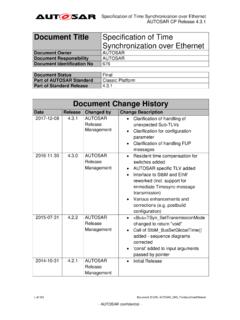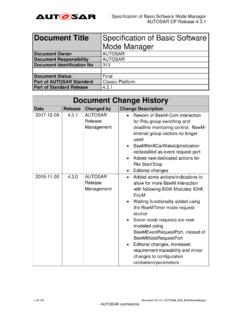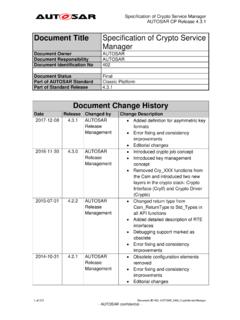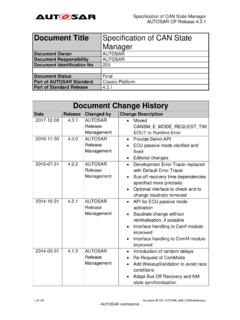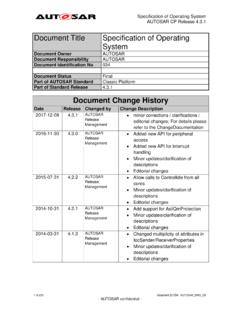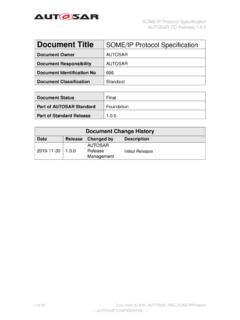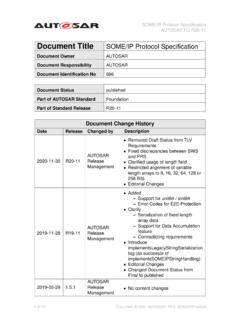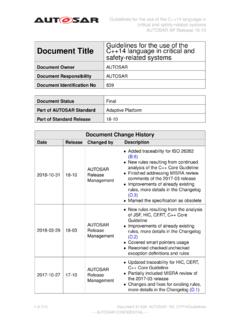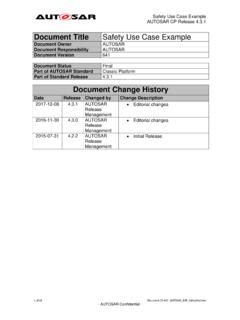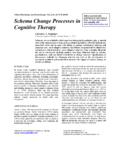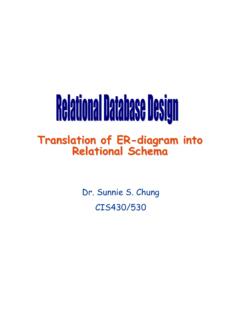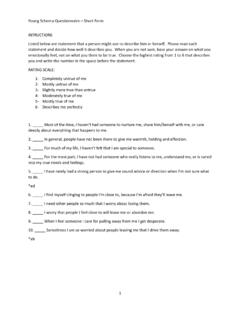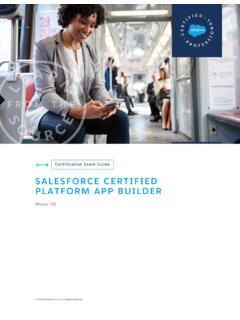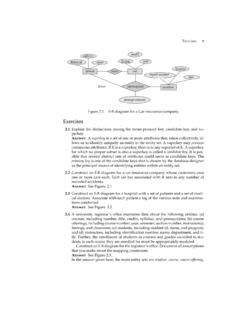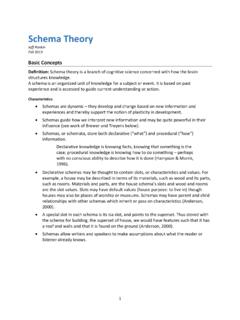Transcription of ARXML Serialization Rules - AUTOSAR
1 ARXML Serialization RulesAUTOSAR CP Release TitleARXML Serialization RulesDocument OwnerAUTOSARD ocument ResponsibilityAUTOSARD ocument Identification No779 Document StatusFinalPart of AUTOSAR StandardClassic PlatformPart of Standard change HistoryDateReleaseChanged update of pattern for AUTOSAR XMLS chema location Initial document structure1 of 25 AUTOSAR CONFIDENTIAL Document ID 779: AUTOSAR_TPS_ARXMLS erializationRulesARXML Serialization RulesAUTOSAR CP Release of 25 AUTOSAR CONFIDENTIAL Document ID 779: AUTOSAR_TPS_ARXMLS erializationRulesARXML Serialization RulesAUTOSAR CP Release work (specification and/or software implementation) and the material contained init, as released by AUTOSAR , is for the purpose of information only.
2 AUTOSAR and thecompanies that have contributed to it shall not be liable for any use of the material contained in this work is protected by copyright and other types of intel-lectual property rights. The commercial exploitation of the material contained in thiswork requires a license to such intellectual property work may be utilized or reproduced without any modification, in any form or byany means, for informational purposes only. For any other purpose, no part of the workmay be utilized or reproduced, in any form or by any means, without permission inwriting from the work has been developed for automotive applications only. It has neither beendeveloped, nor tested for non-automotive word AUTOSAR and the AUTOSAR logo are registered of 25 AUTOSAR CONFIDENTIAL Document ID 779: AUTOSAR_TPS_ARXMLS erializationRulesARXML Serialization RulesAUTOSAR CP Release of Contents1 Document Conventions.
3 Requirements Tracing .. 92 ARXML Serialization Physical Level .. separation .. names .. Data Format .. Character Encoding .. Version .. Comments and Processing Instructions .. Root Element .. Formating / Indention .. 153 Glossary19A change change History of .. Traceables .. Traceables .. Traceables .. 24B Mentioned Class Tables244 of 25 AUTOSAR CONFIDENTIAL Document ID 779: AUTOSAR_TPS_ARXMLS erializationRulesARXML Serialization RulesAUTOSAR CP Release [1] XML schema Production RulesAUTOSAR_TPS_XMLS chemaProductionRules[2] Software Component TemplateAUTOSAR_TPS_SoftwareComponentTem plate[3] System TemplateAUTOSAR_TPS_SystemTemplate[4] Specification of ECU ConfigurationAUTOSAR_TPS_ECUC onfiguration[5] Meta ModelAUTOSAR_MMOD_MetaModel[6] Meta Model-generated XML SchemaAUTOSAR_MMOD_XMLS chema[7] Standardization TemplateAUTOSAR_TPS_StandardizationTempl ate[8] Requirements on Interoperability of AUTOSAR ToolsAUTOSAR_RS_InteroperabilityOfAutosa rTools[9] Extensible Markup Language (XML)
4 , [10] XML schema [11] Generic Structure TemplateAUTOSAR_TPS_GenericStructureTemp late[12] Unified Modeling Language: Superstructure, Version , OMG Available Specifi-cation, ptc/05-07-04 [13] Interoperability of AUTOSAR ToolsAUTOSAR_TR_InteroperabilityOfAutosa rTools[14] Software Process Engineering Meta-Model of 25 AUTOSAR CONFIDENTIAL Document ID 779: AUTOSAR_TPS_ARXMLS erializationRulesARXML Serialization RulesAUTOSAR CP Release IntroductionThis document specifies Rules on how AUTOSAR models are serialized into AUTOSARXML descriptions. The intention of this specification is to support the interoperabilitybetween AUTOSAR tools by specifying additional constraints on the AUTOSAR XMLdescriptions that go beyond the definition of the XML structure that is defined by theAUTOSAR XML schema .
5 Benefits include: Comparison of AUTOSAR XML descriptions is simplified by defining a normalizedrepresentation that avoids meaningless differences such as indention, characterencoding. Effort for tool implementation is reduced by restricting the amount of different fla-vors of XML. different namespace prefixes, character encoding, files names, template specifications define the AUTOSAR Data Exchange Format. Fig-ure shows the relationship between the AUTOSAR ARXML Serialization Rules (thisspecification) and other template specifications: The AUTOSAR XML schema Production Rules [1] and this document focus onthe physical representation and the XML data format.
6 The Software Component Template [2], System Template [3], ECU ConfigurationTemplate [4], etc. address the data structure and its and Semantics ( AUTOSAR Specific Data Structure and Semantics)Physical Representation and XML Data Format(General File System and XML Processing)AUTOSARTPSARXMLS erializationRules AUTOSAR TPS XMLS chemaProductionRulesAUTOSAR TPSG enericStructureTemplate AUTOSARTPSS oftwareComponentTemplateAUTOSAR TPSS tandardizationTemplateAUTOSAR TPSS ystemTemplateAUTOSARTPSECUC onfigurationTemplateAUTOSARTPS<other>Figure : Overview Template SpecificationsAUTOSAR formalizes and maintains the data structure and semantics of theAUTOSAR Data Exchange Format in the AUTOSAR Meta Model [5].
7 The mapping be-tween that meta model and the AUTOSAR XML schema [6] is described in AUTOSARXML schema Production Rules [1] (see figure ). An AUTOSAR Tool that producesan AUTOSAR XML Description has to serialize the AUTOSAR model in a way that it6 of 25 AUTOSAR CONFIDENTIAL Document ID 779: AUTOSAR_TPS_ARXMLS erializationRulesARXML Serialization RulesAUTOSAR CP Release successfully against the AUTOSAR XML schema . Additional constraints thatgo beyond XML schema validation are described in this ModelinstanceOfAUTOSARXML DescriptionAUTOSARTPS ARXMLS erializationRulesinstanceOfFigure : Relationship between XML schema Production Rules and ARXML Serializa-tion Document ConventionsTechnical terms are typeset in mono spaced font, As a generalrule, plural forms of technical terms are created by adding "s" to the singular form, By this means the document resembles terminology used in theAUTOSAR XML document contains constraints in textual form that are distinguished from the restof the text by a unique numerical constraint ID, a headline.
8 And the actual constrainttext starting after thedcharacter and terminated by purpose of these constraints is to literally constrain the interpretation of theAUTOSAR meta-model such that it is possible to detect violations of the standardizedbehavior implemented in an instance of the meta-model ( on M1 level).Makers of AUTOSAR tools are encouraged to add the numerical ID of a constraint thatcorresponds to an M1 modeling issue as part of the diagnostic message issued by attributes of the classes introduced in this document are listed in form of classtables. They have the form shown in the example of the top-level element AUTOSAR :7 of 25 AUTOSAR CONFIDENTIAL Document ID 779: AUTOSAR_TPS_ARXMLS erializationRulesARXML Serialization RulesAUTOSAR CP Release ::AUTOSART emplates::AutosarTopLevelStructureNoteRo ot element of an AUTOSAR description, also the root element in correspondingXML represents the administrative data of anAutosar *aggrThis is the top level package in an :atpSplitable; , represents a possibility to provide astructured comment in an AUTOSAR .
9 Represents an introduction on the AUTOSAR is intended for example to rpresent disclaimersand legal : AUTOSARThe first rows in the table have the following meaning:Class: The name of the class as defined in the UML : The UML package the class is defined in. This is only listed to help locatingthe class in the overall meta : The comment the modeler gave for the class (class note). Stereotypes and UMLtags of the class are also denoted Classes: If applicable, the list of direct base headers in the table have the following meaning:Attribute: The name of an attribute of the class. Note that AUTOSAR does not distin-guish between class attributes and owned association : The type of an attribute of the : The assigned multiplicity of the attribute, how many instances of the givendata type are associated with the of 25 AUTOSAR CONFIDENTIAL Document ID 779: AUTOSAR_TPS_ARXMLS erializationRulesARXML Serialization RulesAUTOSAR CP Release : Specifies, whether the attribute is aggregated in the class (aggraggregation),an UML attribute in the class (attrprimitive attribute), or just referenced by it (refreference).
10 Instance references are also indicated (irefinstance reference) in : The comment the modeler gave for the class attribute (role note). Stereotypesand UML tags of the class are also denoted note that the chapters that start with a letter instead of a numerical value rep-resent the appendix of the document. The purpose of the appendix is to support theexplanation of certain aspects of the document and does not represent binding con-ventions of the verbal forms for the expression of obligation specified in [TPS_STDT_00053] shallbe used to indicate requirements, see Standardization Template, chapter Support forTraceability ([7]).The representation of requirements in AUTOSAR documents follows the table specifiedin [TPS_STDT_00078], see Standardization Template, chapter Support for Traceability([7]).
